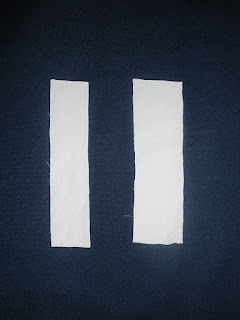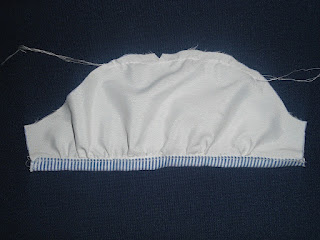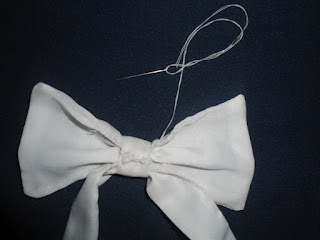While making the stand collar for this dress (which I had mentioned in this post), I thought I could share a short tutorial on how to sew and attach a stand collar. This method is very easy and you can make the collar in a jiffy.
Here is the tutorial:
Cut out two collar pieces (one for the outer collar and one for the inner collar [or facing]) using the stand collar (Mandarin collar) pattern draft posted here. The stand collar I have made here has curved edges and opens at the center front.
You need one more collar piece cut from fusible interfacing. You can iron this on the wrong side of either the outer fabric or facing fabric. This is optional. However, using fusible interfacing will give more firmness to the collar. I didn't use fusible interfacing for this dress. But it looked fine without using it.
Fold the collar pieces by 0.25 inch at the bottom on the wrong side.
With right sides facing, sew the collar pieces together with a 0.25 seam. I have indicated the seam line in red in the photo below.
Clip the curved edges of the collar and turn the collar inside out. Now, sandwich the neckline of the dress between the two collar pieces starting from the curved corners of the neckline on the front bodice.
Pin the collar to the entire neckline.
Whip stitch or hem stitch the base of the collar by hand, making sure with each stitch you catch the base of the outer collar and inner collar (or facing) and the sandwiched neckline with your needle.
Your collar is almost ready now.
Top stitch the base of the collar, and that's it! Your stand collar is done.
Forgive me for the woobly stitches. Perhaps my sewing machine was in a bad mood that day :-)
I have linked this tutorial to the Link Party at Shwin&Shwin.
With right sides facing, sew the collar pieces together with a 0.25 seam. I have indicated the seam line in red in the photo below.
Clip the curved edges of the collar and turn the collar inside out. Now, sandwich the neckline of the dress between the two collar pieces starting from the curved corners of the neckline on the front bodice.
Pin the collar to the entire neckline.
Top stitch the base of the collar, and that's it! Your stand collar is done.
Forgive me for the woobly stitches. Perhaps my sewing machine was in a bad mood that day :-)
I have linked this tutorial to the Link Party at Shwin&Shwin.
You can find lots of free PDF printable sewing patterns on this page on my blog. You can download and use them to create your own clothes.
You can also click the Free Sewing Patterns Page at the top of this blog page (under the blog title) to find more free sewing patterns.
Click the link below to browse all the free PDF sewing patterns for women:
Click the link below to browse all the free PDF sewing patterns for kids:
Click the link below to see the complete list of Free PDF Sewing Patterns for 18-Inch Dolls:
Click the below links to browse through all the pattern drafting and sewing tutorials on my blog.










































































